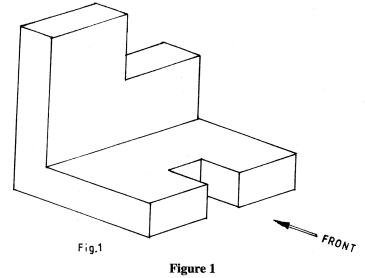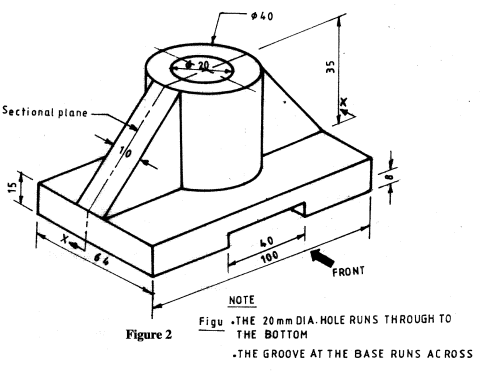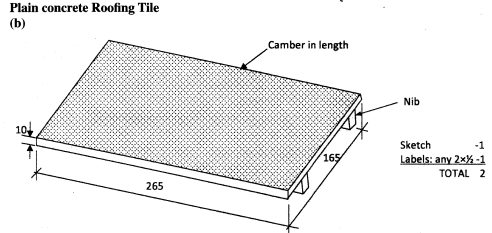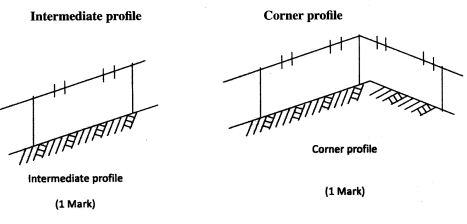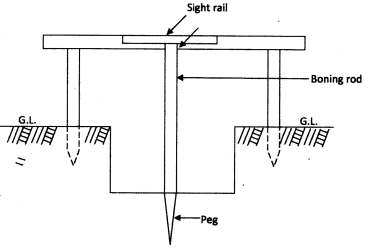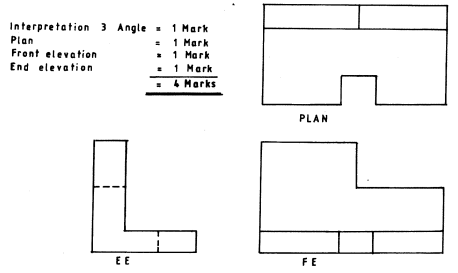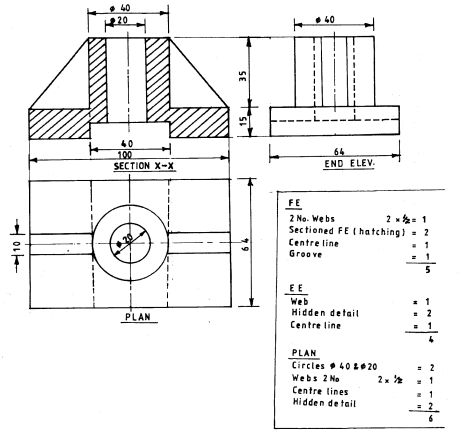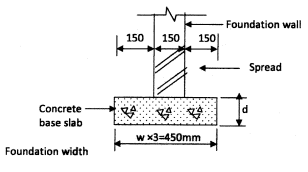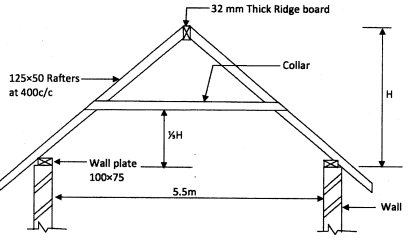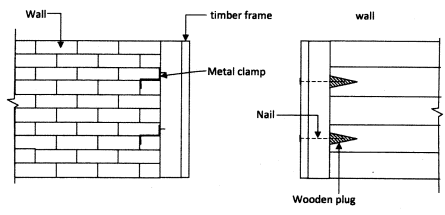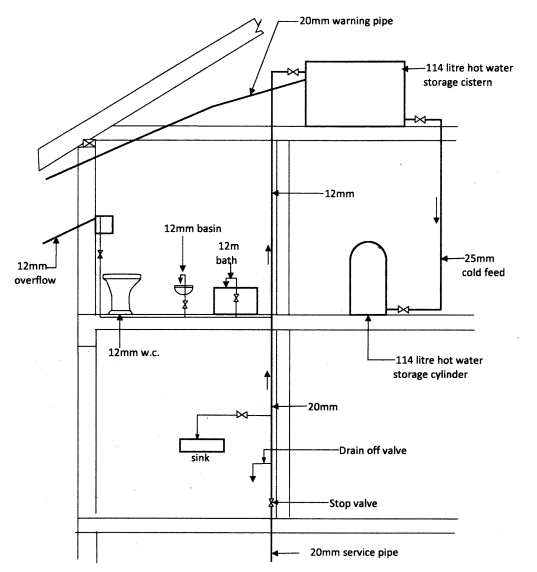SECTION A (40 marks)
Answer all the questions in this section in the spaces provided.
-
- Differentiate between a flat roof and a pitched roof. (2 marks)
- Sketch and label a plain concrete roofing tile. (2 marks)
-
- State two reasons why the current traditional houses are better than caves of the past. (1 mark)
- Distinguish between a turning piece and a centre piece as used in arches. (3 marks)
-
- State one function of each of the following fixings:
- cornice; (1 mark)
- dado rail. (1 mark)
- State four places where a vertical damp proof course may be placed in a building. (2 marks)
- State one function of each of the following fixings:
-
- State the recommended minimum height above the finished floor level for the following electrical fittings:
- switch; (1 mark)
- wall socket outlet. (1 mark)
- State two advantages of each of the following paint finishes:
- matt; (1 mark)
- gloss paint. (1 mark)
- State the recommended minimum height above the finished floor level for the following electrical fittings:
- State four:
- advantages of timber scaffolds over steel scaffolds. (2 marks)
- activities that must be carried out immediately a contractor takes possession of a site. (2 marks)
- Outline the procedure of constructing a foot path finished with precast concrete slabs. (4 marks)
-
- Using line diagrams, sketch the following types of profile boards:
- intermediate profile; (1 mark)
- corner profile. (1 mark)
- State two properties of each of the following materials for making mortar:
- sand; (1 mark)
- water. (1 mark)
- Using line diagrams, sketch the following types of profile boards:
- Sketch and label a vertical cross section of a trench to show the method of establishing a uniform depth using a boning rod. (4 marks)
-
- State two factors to consider when selecting a building site. (1 mark)
- Sketch the following lengthening joints:
- plain scarf joint; (1½ marks)
- splay joint. (1½marks)
- Figure 1 shows a shaped block drawn in isometric.
In 3rd angle projection, sketch the three views of the block. (4 marks)
SECTION B (60 marks)
Answer question 11 on the A3 paper provided and any other three questions from this section in the spaces provided after question 15.
Candidates are advised not to spend more than 25 minutes on question 11.
- Figure 2 shows a pictorial view of a stand.
To a scale of 1:1, draw the following in first angle projection: (15 marks)- sectional front elevation along X-X;
- end elevation;
- plan.
Insert four major dimensions.
-
- A foundation wall is 150 mm thick. With the aid of a labelled sketch, determine the:
- depth of foundation concrete;
- projection of the foundation concrete;
- foundation width (6 marks)
-
- Differentiate between a common rafter and a jack rafter. (2 marks)
- Sketch and label a collar roof showing the mandatory height of the collar. (7 marks)
- A foundation wall is 150 mm thick. With the aid of a labelled sketch, determine the:
-
- State three factors to consider when transporting concrete on site. (3 marks)
- Explain the following terminologies as used in foundations:
- bearing capacity: (2 marks)
- made ground. (2 marks)
- Explain the following activities carried out before laying foundations:
- levelling the bottom; (2 marks)
- consolidation of the bottom; (2 marks)
- pegging; (2 marks)
- wetting. (2 marks)
-
- Outline the procedure of applying a rough cast finish on a new wall. (7 marks)
- Using labelled sketches explain two methods of fixing a timber door frame to a masonry wall.
(8 marks)
- Sketch and label a direct cold water supply system for a one storey building (15 marks)

MARKING SCHEME
-
- To differentiate between a flat roof and a pitched roof
- A flat roof with a pitch 10° or less than 10° to the horizontal base. (1 mark)
- Pitched roof refers to any roof whose angle of slope to the horizontal lies between 10° and 70°.(1 mark)
- Plain concrete Roofing Tile
- To differentiate between a flat roof and a pitched roof
-
- Two reasons why the current traditional houses are better than caves.
- better living conditions.
- caves had no option of design.
- caves are not found everywhere.
Any 2 x ½ = 1 mark
- To distinguish between a turning piece and a centre piece.
- Turning piece:
- Is a small timber or metal support for holding the weight of the arch during construction.
- It is a member used to support arches during construction to a distance not more than one metre in span, hence used for light arch work construction. It has no laggings.
(1½ marks)
- Centre piece:
- Is also a temporary support. Holds larger units in wider or longer spans. It has ribs with laggings spanning across the ribs for provision of strength. It is larger/bigger than the Turning piece.
(Accept sketches)
(1½ marks)
- Is also a temporary support. Holds larger units in wider or longer spans. It has ribs with laggings spanning across the ribs for provision of strength. It is larger/bigger than the Turning piece.
- Turning piece:
- Two reasons why the current traditional houses are better than caves.
-
- One function of:
- Cornice - Timber mouldings used to cover the junction between the wall and the ceiling
- Dado rail - Horizontal timber mouldings fixed in a position to prevent the walls from being damaged by the back of chairs.
2 x 1 = 2 marks
- Four places where a vertical d.o.c. may be placed are:
- Reveals of door and window openings.
- Retaining walls.
- Basement walls.
- Parapet walls.
- Boot lintels in openings.
Any 4x ½ = 2 marks
- One function of:
-
- Recommended minimum heights above finished floor level:
- Switch 1400mm
- Wall socket outlet 325mm
2 x 1 = 2 marks
-
- Advantages of using matt paint finish.
- Avoid reflection of light sources.
- Do minimise surface irregularities if any.
2 x 10 = 1 mark
- Advantages of using gloss paint finish.
- Provides maximum washability.
- Are durable
(2 x ½) = 1 mark
- Advantages of using matt paint finish.
- Recommended minimum heights above finished floor level:
-
- Advantages of timber scaffolds over steel scaffold.
- In areas where timber is available, it is cheap and easy to obtain.
- No fittings required.
- No extra maintenance costs.
- Easily cut to size.
- Wastes and old components can be sold as fire wood and make some money.
Any 4x ½ = 2 marks
- Four activities that must be carried out.immediately a contractor takes possession of a site.
- Fencing the site.
- Clearing the site.
- Setting out the building.
- - Establishing a datum level.
- Constructing site huts
Any 4 x½= 2 marks
- Advantages of timber scaffolds over steel scaffold.
- Procedure of constructing a footpath pavement finished with a precast concrete slab.
- Remove the top soil.
- Fill it up with granular material
- Compact the surface fully to the required gradient
- Lay the pre-cast concrete slab
-
- Sketches to show
- Properties of:,
Sand- Free from too much clay
- Well graded
- Free from organic impurities
Any 2 x ½ = 1 mark
Water - Free from impurities
- Free from sulphates
- Clean/palateable
Any 2 x ½= 1 mark
- Sketches to show
- Method of establishing uniform depth of a trench bottom using a bonning rod.
Sketch 2 marks
labels 4 x ½ = 2 mark
4 marks -
- Factors considered when selecting a site
- Availability of services
- Orientation of site
- Ease of communication
- Site conditions
Any 2 x ½ = 1 mark
- Plain scarf joint
Sketch 1 marks
Naming 4 x ½ = 2 mark
2 x ½ = 3 marks
- Factors considered when selecting a site
-
-
- Foundation dimensions
- Wall thickness W = d = 1/3 spread (s)
∴ W = 150 mm= d = 150 mm
If 150 mm = 1/3S
Then S= 150 x 3 = 450 mm
1 1
Sketch = 3 marks
Labels any 2 x ½ = 1 mark
4 marks
Total = 6 marks -
- Differentiate between a common rafter and a jack rafter.
- Common rafters are the main load bearing members of a roof, they span between the wall plate at eaves level upto the ridge. 1 mark
- Jack rafters are also load bearing rafters but span from ridge to valley rafter or from hip rafter to wall plate. 1 mark
- To sketch and label a collar roof.
Sketch = 4 marks
Labels any 4 x ½ = 2 mark
Mandatory requirements = 1 marks
Total = 6 marks
- Differentiate between a common rafter and a jack rafter.
- Wall thickness W = d = 1/3 spread (s)
-
- Factors to consider when transporting concrete on site:
- distance should be kept to minimum to avoid setting
- container should be watertight
- transport on smooth surface to avoid segregation
- container should be covered when it is raining
Any 3 x 1 = 3 marks
- Terminologies used in foundations
- Bearing capacity - This is the safe load per unit area which the ground can carry.
- Made ground - Is refuse, excavated rock or soil deposited for the purpose of filling in a depression or for raising the site above its material level.
2 x 2 = 4 marks
- Activities carried out before laying foundations
- Levelling the bottom This is a process of forming levels or ensuring that the bottom of the trench is level. It starts from the lowest point along a run of the trench. Pegs are driven into the bottom and levels taken from peg to peg to ensure they are all level. Raised parts are cut while the low parts are filled.
- Consolidation of the bottom The bottom of the trench is raised or compacted to ensure a solid base. This may reveal pockets in the base which are filled and compacted level with the bottom.
- Pegging
Pegs are driven into the bottom of the trench at predetermined distances. These pegs are used in conjunction with the spirit level to ensure a given level for pouring concrete. Concrete is levelled off to the top of the pegs. - Wetting
This is the last preparation done to the bottom of the trench before concrete is poured. Water is sprayed or sprinkled to the bottom of the trench just a fair minutes before concreting starts.
4x2 = 8 marks
- Factors to consider when transporting concrete on site:
-
- Procedure of applying a rough cast finish on a new wall.
- remove any sticking mortar on the wall surface
- clean the mortar joints and remove any protruding mortar on the joints
- fill any holes that may exist along on the wall joint either vertical or horizontal
- sprinkle water on the surface of the wall
- apply the first coat of mortar which should be liquidish using a hard machine sprayer
- apply a second coat with a more thicker coat all over the wall surface
- finish with a third lighter coat to ensure uniform final finish
7 marks
- Two methods of fixing a timber door frame to a masonry wall.
- A metal cramp with a fish tail end is fixed to the back of the frame using wood screws
- A recess/hole is cut in the wall to accommodate the metal cramp and then covered with concrete.
- A hole/recess is cut into the masonary wall to accommodate a wooden plug.
- The plug is driven flush to the wall.
- The frame is nailed to the plug.
Sketches 2 x 2 = 4 marks
labels any 2x ½ x 2 = 2 marks
Explanation 1 x 2 = 2 marks
8 marks
- Procedure of applying a rough cast finish on a new wall.
- Direct cold water supply system
Sketches = 6 marks
labels any 10 x ½ = 5 marks
Fittings in position any 6 x ½ = 3 marks
Direction of flow any 2 x ½ = 1 marks
15 marks
Download KCSE 2012 Building Construction Paper 1 with Marking Scheme.
Tap Here to Download for 50/-
Get on WhatsApp for 50/-
Why download?
- ✔ To read offline at any time.
- ✔ To Print at your convenience
- ✔ Share Easily with Friends / Students

